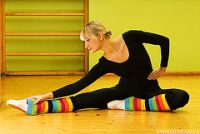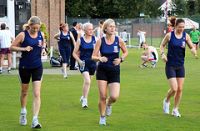Warming Up And Stretching Exercises

To make sure that exercising is as enjoyable an easy on the body as possible, it is crucial to do a correct warm-up before participating in any sports or workouts. Even the fittest athletes can suffer from discomfort or injury by not warming up sufficiently. Bear in mind that the amount of time spent warming up should be relative to the level of physical activity that you are about to partake. A gentle warm-up before a light swim or walk is adequate, but a more complete warm-up is necessary before more heavy activity like tennis or running. Warming up actually increases your body temperature, which then, in turn, increases the flexibility of your muscles, ligaments, cartilage and tendons by making them loose, supple and ready for safe, comfortable exercising. Without doing a responsible and efficient warm-up, you run the risk of sprains, tears and strains, all of which can be much more painful than their names suggest. A correctly done warm-up will also activate joint fluids (which naturally reduces as we age, making it even more crucial for older people), allowing all joints increased lubrication and less likelihood of rubbing or pain. Warming up prepares your body for more strenuous activity, relaxes the mind and increases your level of safety from injury during your exercise. The warming up and stretching exercises on these pages are not only useful to prepare yourself for more strenuous exercise, they are also beneficial in their own right. Not only will they help to keep the body supple and toned, they will also help you feel refreshed and relaxed.

A General Warm-Up:
This should include light activity – for example, a walk before you begin to run or jog – and your fitness level should be taken into account. However, you choose to begin your physical activity, the result should be a light sweat and slight loss of breath, and should last between five and ten minutes. Take longer, though, if necessary. By elevating the heart and breathing rate, your blood flow increases to help with the optimum transportation of oxygen around the body increasing your muscle and body temperature allows stretching to be more effective.

Stretching:
Stretching is one of the most fundamental things we can do with our bodies. It is a basic way of becoming aware of our muscles, bones and skin. We are all aware of our bodies, and may enjoy mental and physical challenges that take our bodies to the limit. Throughout the world there are many exercise disciplines to help us become more in tune with and gain more control over our bodies. Yoga, Tai chi, Pilates, ballet, football, basketball, running and many more all involve an element of stretching, and conversely our performance in these will be enhanced by stretching exercises. Stretching involves putting the body into a position that stretches or causes tension in particular muscles or muscle groups. Gentle stretching is beneficial for general flexibility, particularly in older people whose flexibility has decreased over the years, reduces the likelihood of a strain injury and should last between five and ten minutes. To effectively stretch, put your muscles under tension; slowly increase the level of tension, maintain the position to allow the tendons to lengthen, and then relax. Repeat as often as necessary to feel fully flexible. Never be tempted to miss out on a stretch; lengthened muscles and tendons give your limbs a greater movement range; important in the prevention of injury.Please do not underestimate the power of stretching and its benefits. Many small injuries are caused by the body’s inflexibility. Flexibility also decreases as we age. Therefore, by stretching regularly, we can keep the aging process at bay and enjoy a

better quality of life as we get older. The most effective method of stretching for warming up and cooling down before and after exercise is what is known as static stretching. This involves the gradual stretching of a muscle and does not involve any sudden or jerking movements.

Sports Warm-Up:
After the initial two parts of a warm up, those participating in a particular sport should continue on with warming up by more vigorous activity in keeping with the sport’s requirements. Adapting your sport warm-up is simple. For example, a sports warm up for basketball should include more vigorous shoulder and arm movements – arm swings – as these are parts of the body that will be used over and over during a game and not specifically targeted in the first parts of your warm-up. Sometimes known as dynamic stretches, these are usually more appropriate for serious athletes as there is a degree of risk of injury. Intense stretching uses gentle, but controlled force to move a body part past its normal range of movement. You should have good flexibility before attempting to do this, and to be safe, it should be done under supervision in an exercise class or with a sports trainer where the techniques can be shown properly and adapted to your particular needs. Remember, even if you are not going to participate in a sport, stretching is a beneficial activity in its own right. Try to get into a routine of stretching regularly.